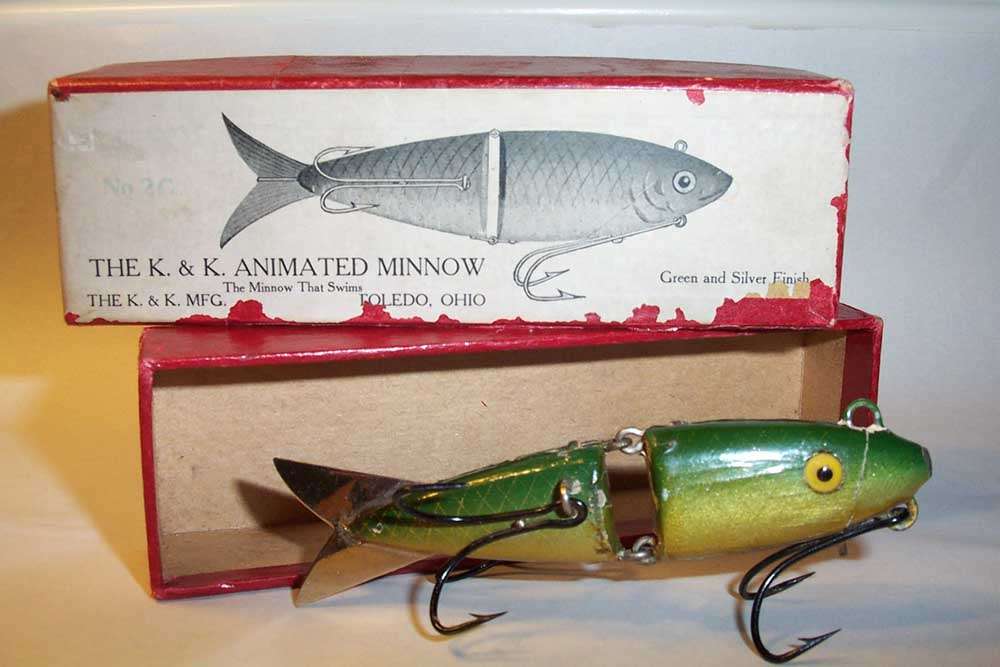
In today’s tackle market, anglers have access to all types of swimbaits … hundreds, in fact. Some are molded from plastics; others are crafted from wood; still others combine these materials — all to form an artificial lure that can swim through the water like a live baitfish.
They obviously sell well, as virtually every tackle outlet on the planet offers them. The reason? Swimbaits catch fish!
Because of their popularity and the fact that there are so many different makes, it made me wonder who actually introduced the first swimbait and when. So I did some research, and what I found might surprise even the most knowledgeable angler.
Your final answer
Many of you may think it was the AC Plug or the Castaic Trout or perhaps some other more obscure brand introduced in the last 30 years or so. If so, you’d be wrong.
Try the year 1906 — January 8, 1906, to be exact.
That’s when a man by the name of John D. Kreisser of Cincinnati, Ohio, applied for a patent for his “K&K Animated Minnow.”
Considered the first ever jointed minnow produced in this country, Kreisser’s lures were shaped from wood and featured a large metal tail fin with breakaway tandem hooks. His unique “hinging” design was eventually granted patent number 857,883 on June 25, 1907.
Although the patent drawing shows Kreisser’s design as a double-jointed, hollow body lure formed from metal, none that match that description are known to exist. Of the few Animated Minnows preserved by collectors, all are made of wood and feature only two body sections.
I guess like many initial designs, the end product became something vastly different — perhaps due to production costs, material restraints or through design improvements. However it occurred, Kreisser’s first production lures were shaped from wood. And thus, he is credited with designing the first “wooden animated minnow”…or, as the box papers state, “The Minnow That Swims.”
Unfortunately, little is known about Kreisser or how the first K&K lures were marketed. Most knowledgeable collectors believe they were sold regionally through small distributors. Then later, as the lure gained popularity, larger wholesalers began to carry them. Among the more notable were Abbey & Imbrie and Abercrombie & Fitch.
Kreisser’s various offerings included the Animated Minnow, Hoochee Coochee, Ghost and Minnoette. Prices ranged from 75 cents to $1.00, which at that time was quite pricey for a fishing lure. But they sold well — largely because there was nothing like them on the market, and obviously because they caught fish.
The sincerest form of flattery
Like all good ideas, there were plenty of imitations to follow. Numerous companies, both large and small, tried copying Kreisser’s design. But back then, lure patents were fiercely defended and he managed to stave off an onslaught of would-be counterfeiters — long enough to secure his share of the market anyway.
Kreisser’s lures were not only designed for bass, he also made them for trout, northern pike, musky and other species of gamefish — simply by offering variations in size, color and body style of the original concept.

Ask an advanced collector where the K&K Animated Minnow falls in desirability and he’ll quickly tell you it’s among the top 10 of the all time classics. If you happen to own one, consider yourself lucky. And if it comes with its original box, you’ve hit it out of the park.
In today’s collector market, a clean, all-original K&K in its correctly marked box could command $5,000 or more. That’s a hefty price for a fishing lure, don’t you think?
So before you complain about the cost of contemporary swimbaits, think what they might be worth down the road … say in another century. Some, I’m sure, will gain value.
Acknowledgements
Many thanks to fellow collectors Joe Stagnitti and David Lindsay for sharing their thoughts and insights on John D. Kreisser and his unique Animated Minnow.
For those of you wanting to learn more about this or other vintage lures, there are numerous books on the subject. Or you can visit www.nflcc.org and www.joesoldlures.com, where you’ll find experts in the field willing to share their knowledge.

